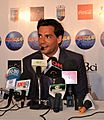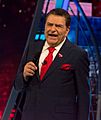Chilean Americans facts for kids
| Chilean-American · Chilenoamericanos | |
|---|---|
| Total population | |
| 172,062 (2018) 0.05% of the U.S. population (2018) |
|
| Regions with significant populations | |
| Miami metropolitan area, San Francisco Bay Area, Greater Los Angeles, New York metropolitan area, Washington Metro Area, Boston, Chicago, Las Vegas Valley | |
| Languages | |
| Chilean Spanish, Mapuche, American English | |
| Religion | |
| Evangelicalism, Roman Catholicism | |
| Related ethnic groups | |
| Chileans, Indigenous Chileans, European Americans |
Chilean Americans are people in the United States who have family roots in Chile. They are also known as chileno-americanos or chileno-estadounidenses.
In 2010, about 126,810 people in the U.S. said they had Chilean ancestors. This makes them one of the smaller Latino groups from South America. Most Chilean Americans live in big cities. You can find many in places like New York, Miami, Los Angeles, San Francisco, and Washington D.C.. After the 1960s, more Chileans came to the U.S. for jobs or school, not just for political reasons. This trend continues today.
Contents
A Look at Chilean American History
Chileans have been in California since the 1850s, especially during the Gold Rush. Not everyone went to the gold fields. Some stayed in cities like San Francisco and San Jose. They often worked as bricklayers, bakers, or sailors. Some even started businesses, importing things like flour from Chile.
In cities, Chileans often lived together in certain areas. In the gold fields, they had their own campsites. In the summer of 1849, Chileans made up most of the people in Sonora. They often worked together to find gold. When the easy gold ran out, Chileans were among the first to find gold from quartz rock. You can still see their influence in names like Chileno Valley and Chili Gulch.
After a big political change in Chile in 1973, many Chileans left their home country. Most went to Europe, but some came to the United States. The U.S. government welcomed these people as "political parolees," meaning they were allowed to stay because of political issues in their home country.
Many streets in San Francisco are named after early Chilean residents. For example, Atherton, Ellis, and Larkin. Chilean women like Mina and Clementina also left their names. In 1975, Chilean people who had left their country started La Peña Cultural Center in Berkeley, California. It is still the biggest Chilean cultural center in the U.S.
Chilean Americans have become successful in many fields. They are entrepreneurs, judges, and musicians. As of 2022, no Chilean American has been elected to the United States Congress.
Why People Immigrate from Chile
Most Chileans have moved to the U.S. since the 1990s. Many left because of political problems or to find better jobs. For example, after the Allende government was overthrown in 1973, many people fled. The U.S. was involved in this change, which led more political exiles to come to America.
Others came to get a better education or to grow their careers. After big earthquakes in Chile, like the 1960 Valdivia earthquake and the 2010 Chile earthquake, many Chileans looked for work in the U.S. Paterson, New Jersey, has become a popular place for them.
Many of the people who came during the time of Augusto Pinochet were well-educated. They often had good skills and knew other Chileans who had also left. After some time, many found skilled jobs. However, some struggled if their job skills were not recognized in the U.S.
The second main wave of Chilean immigrants came for economic or academic reasons. To get a U.S. Visa, people usually need a stable financial background. So, most Chileans coming to the U.S. since 1990 have done so for school or to improve their education.
Chilean American Identity
Chileans are a diverse group. Their family backgrounds can be from Europe, or a mix of Indigenous and European heritage. They often see themselves as both Latino and white. Some Chilean-owned businesses even say they are French or Italian. Many Chilean Americans like to live in suburban neighborhoods. They also have a strong sense of family.
Where Chilean Americans Live
Population by State
The 10 U.S. states with the most Chilean Americans are:
- California – 24,006
- Florida – 23,549
- New York – 15,050
- New Jersey – 8,100
- Texas – 6,282
- Virginia – 4,195
- Maryland – 4,146
- Utah – 3,364
- Massachusetts – 3,045
- Illinois – 2,753
Population by Urban Area
The largest groups of Chilean Americans live in these urban areas:
- New York-Northern New Jersey-Long Island, NY-NJ-PA MSA – 20,688
- Miami-Fort Lauderdale-Pompano Beach, FL MSA – 17,161
- Los Angeles-Long Beach-Santa Ana, CA MSA – 10,471
- Washington-Arlington-Alexandria, DC-VA-MD-WV MSA – 6,963
- San Francisco-Oakland-Fremont, CA MSA – 4,000
- Boston-Cambridge-Quincy, MA-NH MSA – 2,622
- Houston-Sugar Land-Baytown, TX MSA – 2,570
- Chicago-Joliet-Naperville, IL-IN-WI MSA – 2,454
- Riverside-San Bernardino-Ontario, CA MSA – 2,066
- Orlando-Kissimmee-Sanford, FL MSA – 1,884
- Atlanta-Sandy Springs-Marietta, GA MSA – 1,779
- Seattle-Tacoma-Bellevue, WA MSA – 1,776
- San Diego-Carlsbad-San Marcos, CA MSA – 1,730
- Dallas-Fort Worth-Arlington, TX MSA – 1,686
- Philadelphia-Camden-Wilmington, PA-NJ-DE-MD MSA – 1,505
- Salt Lake City, UT MSA – 1,463
- San Jose-Sunnyvale-Santa Clara, CA MSA – 1,397
- Las Vegas-Paradise, NV MSA – 1,376
- Tampa-St. Petersburg-Clearwater, FL MSA – 1,215
- Phoenix-Mesa-Glendale, AZ MSA – 1,211
Population by City
Here are some cities with the most Chilean Americans:
- New York City, New York – 7,026
- Los Angeles, California – 4,112
- Miami, Florida – 1,427
- Houston, Texas – 934
- San Diego, California and Chicago, Illinois – 876
- San Francisco, California – 754
- Miami Beach, Florida – 739
- Washington, DC – 697
- San Jose, California – 632
- Doral, Florida – 622
- Kendall, Florida – 613
- Hialeah, Florida – 602
- The Hammocks, Florida – 564
- Pembroke Pines, Florida – 558
- Fontainebleau, Florida – 549
- Hollywood, Florida – 542
- Kendale Lakes, Florida – 469
- Las Vegas, Nevada – 467
- Boston, Massachusetts – 405
- San Antonio, Texas – 374
- Union City, New Jersey – 372
- Charlotte, North Carolina – 368
- Philadelphia, Pennsylvania – 357
- Coral Springs, Florida – 342
- Miramar, Florida and Austin, Texas – 340
Population by Percentage
These U.S. communities have the highest percentage of Chileans compared to their total population (Source: Census 2010):
- Brookeville, Maryland – 3.73%
- Manorhaven, New York – 3.57%
- Oyster Bay, New York – 2.67%
- Warm Springs, Virginia – 1.63%
- Dover, New Jersey – 1.55%
- Key Biscayne, Florida – 1.50%
- Sleepy Hollow, New York – 1.48%
- Forest Home, New York – 1.40%
- Doral, Florida – 1.36%
- Victory Gardens, New Jersey – 1.32%
- Wharton, New Jersey – 1.27%
- The Crossings, Florida – 1.18%
- The Hammocks, Florida – 1.11%
- Inwood, New York – 1.10%
- North Lynbrook, New York – 1.01%
Only fifteen communities in the U.S. have more than 1% Chilean residents. Most of these are in Miami-Dade County, Morris County, NJ, and Nassau County, NY.
Chilean Traditions and Customs
Many Chilean customs fit well with American life. The Chilean workday is much like the American one. Most business people work 45 hours a week, from 8:30 am to 6:30 pm, with a lunch break. They might also work overtime. However, many Chileans outside Santiago go home for lunch. This is not as common in the U.S. or among Chilean Americans.
Unlike the usual American diet, Chileans often have four meals a day. They have breakfast, lunch, tea (called onces) around five o'clock, and a late dinner. Many people have onces in the early evening and skip dinner. Interestingly, Chile is one of the few Latin countries where tea is more popular than coffee. This is different from what most Americans drink.
Notable Chilean Americans
-
Actor Pedro Pascal
-
Laser physicist Frank Duarte
-
Actress and model Leonor Varela
-
Actress Cote de Pablo
-
Nobel laureate Gabriela Mistral
-
Actor Cristián de la Fuente
-
TV host Don Francisco
-
Actor Santiago Cabrera
Here are some well-known Chilean Americans:
- Alexa Guarachi – Tennis player
- Los Abandoned – A rock band
- Marjorie Agosín – Poet and professor
- Fernando Alegria – Stanford professor
- Marsia Alexander-Clarke – Video artist
- Isabel Allende – Famous writer
- Fernando Alvarez – Jockey
- Cayetano Apablasa – Land owner and politician
- Tom Araya – Musician
- Claudio Arrau – Pianist
- Felipe Bazar – U.S. Navy hero
- Natascha Bessez – Singer
- Nico Bodonczy – Soccer player
- Daniel Borzutzky – Poet
- Charissa Chamorro – Actress
- Charmaine – Musician
- Beto Cuevas – Singer
- Angélica Castro – Former model and TV presenter
- Cristian de la Fuente – Actor
- Patricia Demick – Boxer
- Ruperto Donoso – Jockey
- Ariel Dorfman – Author and educator
- Juan Downey – Artist
- Frank J. Duarte – Laser physicist
- Matias Duarte – Inventor
- Sebastian Edwards – Economist
- Paloma Elsesser – Fashion model
- Julio M. Fernandez – Biologist
- Pablo Francisco – Comedian
- Alberto Fuguet – Writer and film director
- Thelma Furness, Viscountess Furness – A social figure
- Jorge Garcia – Actor
- John Gavin – Actor
- Lisa Guerrero – Sportscaster and actress
- Tommy Guerrero – Skateboarder and musician
- Claudio Guzmán – Television director
- Sophia Hayden – Architect
- Fareed Haque – Guitarist
- Alfredo Jaar – Artist and filmmaker
- Nicolas Jaar – Composer
- Alain Johannes – Musician
- Paulina Kernberg – Child psychiatrist
- Mario Kreutzberger – Also known as Don Francisco, a TV host
- Juan Pablo Letelier – Politician
- Jason Liebrecht – Voice actor
- Vicente Luque – MMA fighter
- Antonio Macia – Screenwriter and actor
- Paloma Mami – Singer
- Benny Mardones – Singer
- Roberto Matta – Painter
- Gordon Matta-Clark – Artist
- Claudio Miranda – Novelist and filmmaker
- Gabriela Mistral – Nobel laureate
- Daniella Monet – Actress
- Harry Hays Morgan Jr. – Diplomat and actor
- Mauro E. Mujica – Chairman and CEO of U.S. English
- Gloria Naveillán – Politician
- Ricardo A. Olea – Engineer and scientist
- America Olivo – Actress and singer
- Cote de Pablo – Actress and singer
- Frank Pando – Actor
- Marko Zaror – Actor
- Pedro Pascal – Actor
- Nicole Polizzi – Reality TV personality
- Promis – Singer-songwriter
- Jose Quiroga – Cardiologist
- Horatio Sanz – Comedian
- Elizabeth Schall – Singer-songwriter
- Sebastian Soto – Soccer player
- Elizabeth Subercaseaux – Writer
- Mahani Teave – Classical pianist
- Ryann Torrero – Soccer player
- Steve Thurston – Journalist and entrepreneur
- Mercedes Valdivieso – Writer and professor
- Arturo Valenzuela – Professor
- Francisca Valenzuela – Singer-songwriter
- Leonor Varela – Actress
- Andres Velasco – Economist
- Alexander Witt – Director
Chileans Around the World
Many Chileans live outside of Chile. Out of about 857,781 Chileans living abroad, about 13.3% (114,084) live in the United States. Most Chileans living outside their home country, about 50.1%, live in Argentina. Smaller groups live in Sweden, Canada, and Australia. The rest are spread out in other countries, especially in the European Union.
See Also
 In Spanish: Inmigración chilena en los Estados Unidos para niños
In Spanish: Inmigración chilena en los Estados Unidos para niños
- Demographics of Chile
- Latino conservatism in the United States
- Chileans in the United Kingdom
- Chilean Australian
- List of Chileans
- Chile–United States relations
Images for kids
-
Paterson, New Jersey, is a growing home for Chilean immigrants.
-
Lisa Guerrero is an American journalist and actress.
-
Mahani Teave, a classical pianist.
-
Isabel Allende, a famous author.



















